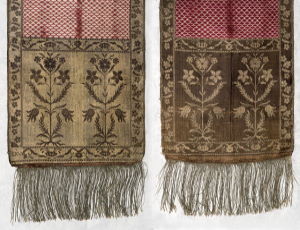
'Exhibit of the Month' is a series initiated by the Jagiellonian University Museum with the beginning of the new academic year. Each month we will explain the Museum collection to you, choosing a single exhibit or a group of exhibits which usually are not shown to the open public. This month's feature is an 18th-century kontush belt.
Kontush sash
During the sixteenth century, an indispensable element of the Polish nobility's attire became a silk belt, sometimes enriched with metal threads, which was a luxurious product of Oriental craftsmen. Sashes of this type were brought to Poland from Turkey, Persia and even India by Armenian merchants. When the Afghan invasion of Persia in 1722 closed the key routes for the Polish-Lithuanian Commonwealth’s Asian trade, workshops owned by Armenians began to spring up in Istanbul, producing belts especially for the Polish market. From about the middle of the eighteenth century, Armenian craftsmen began to move to the Commonwealth lands, under the protection of the magnates, in whose estates they established manufactories producing belts—the so-called Persian workshops. Around 1767, under the auspices of the Radziwiłł family, the most famous of those workshops was established in Słuck, managed by Jan Madżarski and later by his son Leon. Sashes were also manufactured in Grodno, Kobyłka, Cracow, Warsaw-Lipków, as well as—on a smaller scale—in Sokołów, Korzec, Gdańsk, Kutkorz and other, unknown places. In the period of the Four-Year Sejm, the intensification of patriotic feelings among the nobility led to a true renaissance of Polish national costume. The demand for kontusz sashes was so great that the output of local workshops proved insufficient. This situation provided an opportunity for weaving manufactories in Lyon since they were already looking for new markets. French girdles, imitating Eastern products, were perfectly suited to the taste of the ‘Sarmatian’ public. Sashes for Polish clients were also made in Berlin and Venice. The less wealthy had to content themselves with cheap sashes imported from Russia.
The kontusz sashes were usually made in the technique known as taqueté façonne (labelled in Polish literature as the so-called Mediterranean technique ). It consisted of the use of a double warp and multiple wefts. The fabric was woven entirely in plain weave; patterns were introduced using the lancing technique (the weft threads of the pattern passed through the entire width of the fabric) and the broaching technique (the weft threads of the pattern were introduced only within the motif). The kontusz belts were usually double-sided. In order to obtain the effect of a four-sided belt, it was divided lengthwise into two halves, which differed in colour and sometimes also in pattern. Taqueté façonne was a very time-consuming technique. It could take a whole year to finish a single sash.
The composition of kontusz sashes is built up by the so-called heads (fields on their ends), the middle section (usually divided by transverse stripes) and the edges. The repertoire of patterns consisted mainly of stylised floral motifs and geometric motifs.
The belt on display, from the collection of the Jagiellonian University Museum (inv. no. MUJ 1130), is semi-sheer (enriched with silver metal thread only in the heads), double-sided, made in the technique of taqueté reversiblé (a variant of taqueté façonne, involving the introduction of patterns solely by means of the lancing technique). The pattern in the heads is formed by two symmetrical, floral bushes, the middle section (in this case without stripes) is filled with the so-called fish scale motif, and the borders are decorated with flowered twigs. A silver tassel is sewn to the ends of the belt. At the four corners of the belt there is a signature: SF.
The ornamental motifs on the sash are reminiscent of the products of the manufactory of the Armenian Jakub Paschalis Jakubowicz, who moved from trading in sashed (ordered in Lyon and Cracow) to producing them, establishing his own workshop in 1787, first in the capital and then in Lipków near Warsaw. Jakubowicz was ennobled in 1790 for his contribution to the development of the craft and was granted the coat of arms Jakubowicz I (a variant of the Junosza coat of arms). The letters SF marked products from an unknown Kraków workshop working for Paschalis. Such signed sashes were also made in Lyon. Jakubowicz collaborated with French weavers, commissioning them to produce sashes according to his own designs, but later complained that the sashes available on the market were marked FS, the poor quality of which damaged the reputation of his excellent products.
The sash in question belonged to Professor Tadeusz Milewski (1906-1966), a linguist, prisoner of the concentration camps in Sachsenhausen and Dachau, long-time lecturer at the Jagiellonian University, dean of the Faculty of Philology of the Jagiellonian University from 1958 to 1960. The professor made a valuable gift to the Jagiellonian University Museum: seven kontusz belts and a collection of antique clocks.
ILLUSTRATIONS[Podział zawijania tekstu]1. Portrait of Stanisław Antoni Szczuka, ca. 1735-1740; source: Wikipedia.
2. Portrait of Jan Piędzicki, of the Topacz coat of arms, painted by Józef Faworski, 1790. Józef Faworski, 1790; source: Wikimedia.
3. Diagram of a kontush sash composition; source: J. Chruszczyńska, Kontusz sashes from Polish manufactories and workshops in the collection of the National Museum in Warsaw. Warsaw 1995.
4. Kontush sash from the collection of the Jagiellonian University Museum; photo: Janusz Kozina.
5. Signature of a sash (letters SF) from the collection of the Jagiellonian University Museum; photo: Janusz Kozina.
6. Jakub Paschalis Jakubowicz; source: Wiki.Armenians.
7. Professor Tadeusz Milewski; source: biografik.up.krakow.pl

